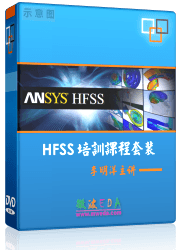- 易迪拓培训,专注于微波、射频、天线设计工程师的培养
HFSS15: Materials in Time Domain
In any time-domain method, handling frequency-dependent material parameters is not straightforward. Two important cases, frequently encountered in electromagnetic simulations, are (1) non-perfectly conducting metals and (2) lossy dielectric materials.
In most high-frequency applications, one does not solve for fields inside non-perfectly conducting metals. Rather, the skin effect is expressed with a boundary condition on the surfaces of the metal. Since the skin impedance is frequency dependent, containing a factor √(frequency), a suitable way has to be found to approximate this in the time domain. In HFSS Transient, the Padé approximation [ ] is used. With this approximation one can expect accurate results over a very wide band which includes the highest frequency of interest. Near DC, a modest reduction in accuracy is to be expected.
Lossy dielectric materials can be described by a bulk conductivity σ or by a loss tangent tan(δ). If the conductivity is the only loss mechanism, the relation between the two is tan(δ) = σ/(2π×frequency ×ε0εr). In any case, the loss tangent of a material is frequency dependent, and a suitable way has to be found to approximate it in the time domain. In HFSS Transient, when a lossy dielectric is specified with a certain loss tangent at the highest frequency of interest, the Debye model is used to describe the material for all frequencies. The Debye model is more realistic than the assumption of a constant loss tangent. If one uses the Debye model in the frequency domain as well, one can expect the same results as in the time domain, except when the material touches a port. That case is discussed in the next section.


